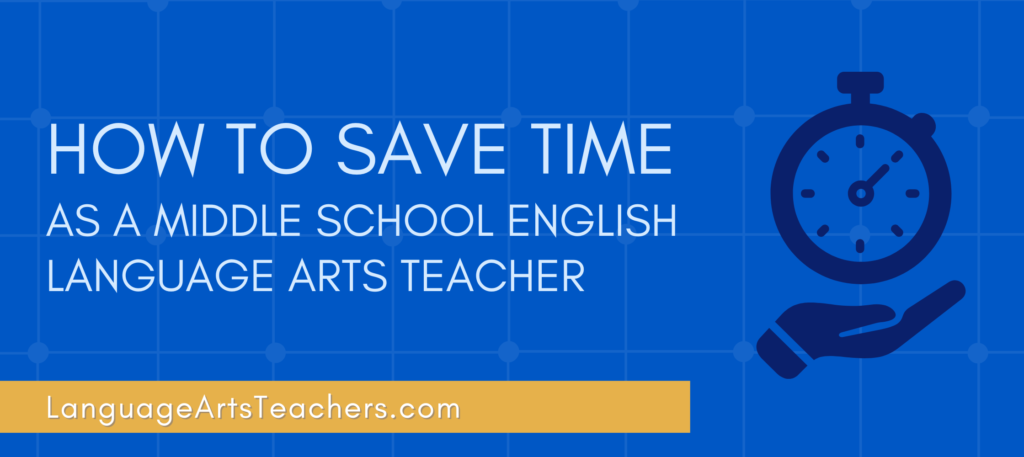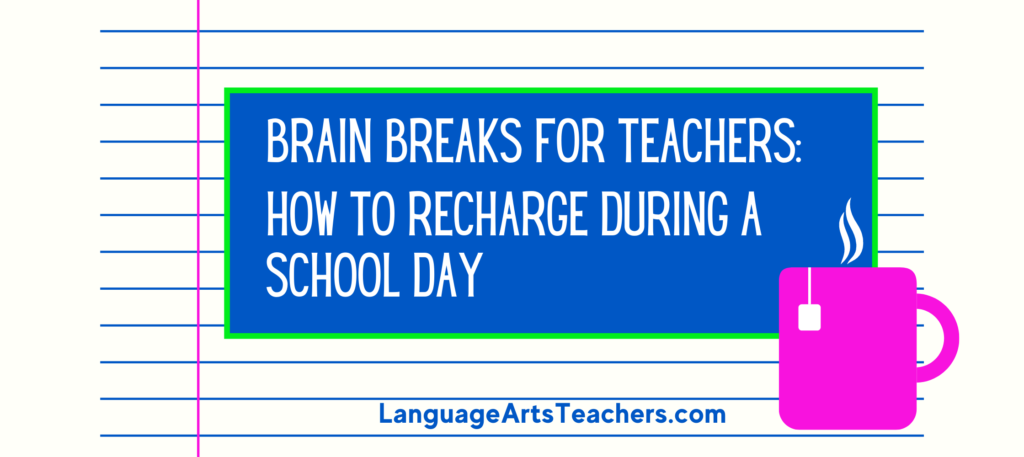A teacher friend of mine admitted to me that she got caught grading papers in class.
Now let me tell you—she wasn’t sitting at her desk back in the corner of her room while her 6th graders watched a pointless movie or took selfies. It was nothing like that.
What happened was she had a test scheduled that day in class. Her students had participated in a Socratic seminar-type discussion the day before as a novel review, so their desks were still arranged in a large circle. She kept the desks the same and gave them the test (open-ended short answer questions that they got to choose from and then use their novels for text evidence).
Good stuff, right?
She sat down in an empty desk in that circle right there with her students as they worked through the test. She had a stack of papers from her previous class that she decided to read through and begin grading. Instrumental “writing” music played softly in the background and her one chiclet-sized window was open with a light, fresh breeze wafting through the room.
It’s an ideal work environment, for sure.
In walked one of the assistant principals. No biggie. The three principals are always popping in and out of classrooms. The students and teachers are used to it. It’s a good thing because it helps them stay in tune with some of the things happening across the school.
After moving around the room observing the students working and looking at the test itself, he approached my teacher friend. He leaned over and said these words: “District officials frown on teachers sitting down and grading papers during class time. I know it’s the end of the day and you’re tired, but you really need to be moving around and actively monitoring your class.”
She was floored! Again, it’s not like she was ignoring her kids to check random emails or to shop online! She was sitting with them, the classroom was an ideal working environment, and she was going to be able to return those tests the very next day (immediate feedback!!) to her students.
How could this happen?
That’s where we are, guys. We teach in a world where we must appear to be 100% involved in everything our students are doing at all times. We must not record grades, grade papers, organize materials, or sit down for 10 minutes in front of them. All that must be done behind the scenes in order to become the best “helicopter teachers” we can be (remember when that phrase only applied to parents??).
My friend was confused, then embarrassed, and finally she became angry about what the assistant principal said to her (even though he spoke softly, it was still right there in class with her students all around her!).
We discussed her approaching the assistant principal to engage him in a calm, professional conversation about what was happening in her class that day, but she didn’t want to come across as sounding defensive or immature or as trying to make excuses.
So I shared with her my own sneaky ways of how I go about grading papers in class while my students are working.
Now I don’t do this all the time, but I do it as much as I need to. I’ve had principals and even (surprise!!) central administrative “officials” pop in from time to time and let me tell you— It has never looked to them like I was “just sitting there grading papers.” How do I know? Because you know they would have said something!!
Here are my TOP 3 TIPS for getting sneaky about grading papers right there in class (and not getting caught)!
1) The Clipboard Strategy
I’m starting with my absolute favorite, easiest strategy. What I do is I clip a stack of papers onto my clipboard with a seating chart or roster or a couple copies of whatever assignment my students are currently working on. (I only do this when my students are truly working independently… So maybe a couple times a week or so).
I move around the room, sitting in different locations (always near or among my students, but to where even they don’t know that I’m grading their papers… Otherwise they’ll ask nonstop if I’ve gotten to theirs yet.).
If what I’m grading consists of open-ended questions, I read and grade holistically (they either get a 1, 2, 3, 4, or 4+ which represents a 60, 70, 80, 90, or 100). I shift papers around and move through them pretty quickly since I’m also keeping an eye on my students, answering their questions and monitoring them. I spend no more than maybe 40 seconds per paper (grade quickly, go with your gut, and focus on looking for only 1-2 main things when grading open-ended questions like this). Super easy. Done. Call it a day!
If what I’m grading consists of multiple choice (which I rarely use), I jot down the answers on a sticky note and attach it to the clipboard itself. Then as I run through the papers, those letter answers become stuck in my head and I’m able to flip through and grade those papers pretty quickly.
As an alternative to the Clipboard Strategy, you could also place all the papers into a small, empty 1” binder that you can easily snap shut at a second’s notice if needed. Assuming your students wrote on or filled out papers that have holes punched in them, it’s worth it to take a minute and place them inside a binder. You can move all over your room, sitting down here and there to grade a few papers at time, and it simply looks like you have a notebook full of… who knows? Lesson plan ideas? Resources? Seating charts or extra paper? You could always just keep those things at the front of the binder at all times with student papers stuffed behind it!
2) The Small Group Strategy
Ok, this strategy really is about helping students and providing immediate, useful feedback to them in real time. It’s also an amazing way to get grades done! Even if you can’t get through a whole class at one time (which you really can’t unless you’re blessed with a 90 minute class period and 15 students), a little at a time does add up!
So here’s the Small Group Strategy:
Let’s say you’re at the point in class where you have 25 minutes left and you’ve moved from the mini-lesson portion to the small group practice or even to the independent practice part of class. Either way, it doesn’t matter.
Let’s say you’ve got a stack of papers in your hand from yesterday that you do NOT want to stay late to grade. If you know your students at all (which you should), then you probably know which ones work really well together, which ones understand concepts at about the same level, which ones tend to struggle on some of the same things, etc.
So as your class is working, call four or five students over to your “teacher table” (not your desk… just some other area in the room where you can talk with them for a few minutes). Pass back their papers (just their own—not other students’ papers) and yes, it’s fine for them to have their own papers!
Tell them you want to look at their work together and allow them to talk about their answers. Re-teach and clarify as needed. Let students share answers by talking aloud about them. Put them in charge of deciding if they truly answered the question, if they even understood the question itself, etc.
Guide them to tell YOU what it seems like their grade should be!
Maybe it’s pretty straightforward because it’s multiple choice or because it’s just a cut-and-dry type of assignment. Or, maybe it’s not so easy. Perhaps it’s a short answer writing kind of assignment. Either way, let them talk about their own strengths and weaknesses regarding their work.
Assign a grade right there, and record the grade in real-time! Keep the papers to return later, and move on to calling up another group of students.
This doesn’t have to take a ton of time, either! Less than 10 minutes per group is totally sufficient. Even if you only had 25 minutes left in class, wouldn’t it be beneficial to have up to 10 students’ grades done? That could very well be a third of your students whose papers have been graded!
The more you do this, the more your students will get used to you doing this, and the quicker you’ll be able to do it, too.
Should an unannounced classroom visitor come in, they’ll see you as someone who conferences with kids, who can provide re-teaching with a small group while other students work on independent assignments or in other small groups.
They’ll see you as someone who can differentiate instruction for their students’ needs based on different things happening in the classroom simultaneously.
And it’s true! you’re not putting on a front of any kind. It’s just that this is a wonderful strategy not only to connect with your students and help them to take ownership of their work, but to record some grades and lesson your own load as well!
Plus, if even a fraction of your students anticipate you calling them up at some point to go over their work with them after they’ve already turned it in, then isn’t that another way to hold them accountable and help them (at least some of them!) want to do a better job and work more carefully the first time? It’s a win-win situation, for sure!
3) The “I’m Not Sitting at My Computer Entering Grades” Strategy
I’m going to confess here. I had just started teaching at a new school and it was maybe the third or fourth week after school began… I was already feeling behind with grades!
Oh, my papers were graded, but I just wasn’t entering them in the computer quickly enough!
So while my students worked on a writing assignment, I sat down at one of the student computers in my room (thank goodness I had the sense NOT to sit at my own desk against the wall to use my own computer). I logged into my online grading platform and proceeded to enter grades.
If I could just get these grades entered before school let out!!!
In walked the principal for a surprise visit.
Crap!!!
All I could think about was how lame it was to be sitting there entering grades during class! Hey, I was all over the room earlier in the day and by now, I just wanted to get it done!
Right then and there I had a thought… I called the name of the student whose grade I had just entered. She got up, walked over to where I was sitting, and sat down in the chair next to mine. I pointed to her grade and told her I had just entered her quiz grade from two days ago along with her project grade from last week. I then showed her the updated average. She was happy and asked if today’s quiz would also be added by the end of the week so she could have an even higher grade soon. I answered her question and sent her back to her seat.
While this was happening, the principal moved around the room, looking at the walls and the students’ assignment and generally just checking things out.
I called the next student whose grade I had just entered. He walked over, sat down, and I went through the same process with him, showing him the updated grade and explaining what else I would be entering for him that week.
What I discovered was that first of all, kids starting waiting excitedly for “their turn.” They liked getting to see what a couple of assignments did to change their grade averages.
The principal, I know for a fact, didn’t see me as the teacher sitting down entering grades on her computer while ignoring her students (even though I admit that that’s what I was originally doing). The principal saw me as a teacher who conducted individual conferences with her students, keeping them updated on their progress. She loved it! Even more importantly, my students loved it and I started planning time to do this at least once every other week.
To this day, I still use this strategy with students and I teach other teachers how and when to do it, too, because it’s so beneficial for kids (and teachers, too!).
I learned something else, though. As long as I’m involving my students in the grading process, and as long as I’m interacting with them, I can actually get a TON of grading done right there in the classroom.
You can do this as well. If you can create the kind of classroom where it’s normal for you to sit among your students from time to time and where it’s a common thing for them to talk with you about their grades and about their assignments, then it really does lessen what you take home (or stay late) to grade.
It’s not always about being sneaky. I discovered these three strategies for lessening my grading load out of necessity and exhaustion and overwhelm. I discovered ways to meet my students’ needs while simultaneously meeting my own needs (not taking home stacks and stacks of papers to grade each weekend or staying at school late every day).
What ideas or strategies do YOU have that helps your students while also making things easier and more manageable for you? I’d love to hear them!




